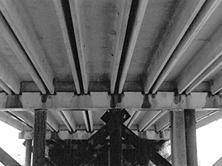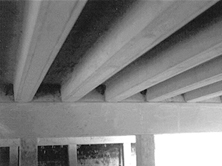 Nash County Bridge 143 over Stoney Creek near Nashville, built 1959 with no fill between channels of beams (source: NCDOT bridge inspection files).
Nash County Bridge 143 over Stoney Creek near Nashville, built 1959 with no fill between channels of beams (source: NCDOT bridge inspection files). The State Bridge Maintenance Unit used its own in-house talent to work with ideas about prestressed concrete bridges developed in other parts of the country in the early- to mid-1950s. It came up with several prestressed concrete designs that could be used for standardized and relatively short-span bridges.
The first North Carolina prestressed concrete bridges were slab bridges composed of precast blocks, up to a depth of 36 inches, tensioned by steel rods passing through holes inside the blocks. This design had first been used in Tennessee and developed by consulting engineer Ross H. Bryan of Nashville. Bryan collaborated with engineers of the State Bridge Maintenance Unit for North Carolina's first example, built in August 1954 near Turkey in Sampson County. The blocks were cast by the Smith Concrete Products Plant in Kinston. Unfortunately, the inventory identified no surviving examples of the block slab bridges.
 Nash County Bridge 204 over a tributary of Basket Creek near Nashville, built 1956, with fill between legs of channel beams (source: NCDOT bridge inspection files).
Nash County Bridge 204 over a tributary of Basket Creek near Nashville, built 1956, with fill between legs of channel beams (source: NCDOT bridge inspection files). The next known use of prestressed concrete in North Carolina was for channel beam bridges. These are the oldest surviving prestressed concrete bridges in the Historic Bridge Inventory.
While the concept of a channel beam (a beam with a C shape) was not new, it came into its own after World War II as an economical and quickly erected bridge type, first in reinforced concrete and later in prestressed concrete. It also found widespread application in a variety of other structures, including parking garages and roof trusses.
The State Bridge Maintenance Unit adopted two standard, prestressed concrete channel beam designs in 1956. The first was for channels of 20-, 25-, or 30-foot-long spans and 15-ton (H15) truck loads. This was a straightforward channel-beam bridge with the beams stiffened by transverse ties and the adjacent channels also serving as the deck.
The second of the designs was unusual, likely unique to North Carolina. It combined the prestressed concrete channels with a cast-in-place, reinforced concrete, slab deck and fill between the legs of the channels. This was a composite structure. The fill was more than a key way to tie the channels together; it was also necessary for the load-carrying action in order to achieve a 20-ton design load.
The channel-beam bridges helped North Carolina meet its need for quickly erected, economical, short-span bridges on secondary roads.